
Thyreophora is a group of armored ornithischian dinosaurs that lived from the Early Jurassic until the end of the Cretaceous.

Ankylosauria is a group of herbivorous dinosaurs of the clade Ornithischia. It includes the great majority of dinosaurs with armor in the form of bony osteoderms, similar to turtles. Ankylosaurs were bulky quadrupeds, with short, powerful limbs. They are known to have first appeared in the Middle Jurassic, and persisted until the end of the Cretaceous Period. The two main families of Ankylosaurs, Nodosauridae and Ankylosauridae are primarily known from the Northern Hemisphere, but the more basal Parankylosauria are known from southern Gondwana during the Cretaceous.
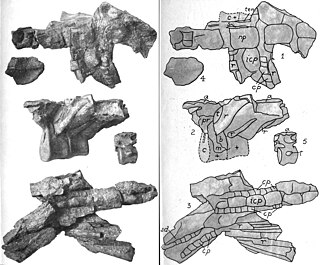
Nodosaurus is a genus of herbivorous nodosaurid ankylosaurian dinosaur from the Late Cretaceous, the fossils of which are found exclusively in the Frontier Formation in Wyoming.

Hylaeosaurus is a herbivorous ankylosaurian dinosaur that lived about 136 million years ago, in the late Valanginian stage of the early Cretaceous period of England. It was found in the Grinstead Clay Formation.

The Iguanodontia are a clade of herbivorous dinosaurs that lived from the Middle Jurassic to Late Cretaceous. Some members include Camptosaurus, Dryosaurus, Iguanodon, Tenontosaurus, and the hadrosaurids or "duck-billed dinosaurs". Iguanodontians were one of the first groups of dinosaurs to be found. They are among the best known of the dinosaurs, and were among the most diverse and widespread herbivorous dinosaur groups of the Cretaceous period.

Aletopelta is a monospecific genus of basal ankylosaurid dinosaur from Southern California that lived during the Late Cretaceous in what is now the Point Loma Formation. The type and only species, Aletopelta coombsi, is known from a partial skeleton preserving osteoderms. It was originally described in 1996 by W. P. Coombs, Jr. and T.A. Deméré before being named in 2001 by Tracy Ford and James Kirkland. Aletopelta has an estimated size of 5 metres and weight of 2 tonnes. The holotype formed a miniature reef and was scavenged upon by invertebrates and sharks.
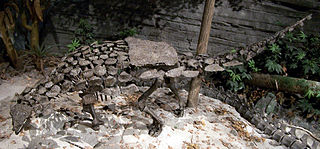
Nodosauridae is a family of ankylosaurian dinosaurs, from the Late Jurassic to the Late Cretaceous period in what is now North America, South America, Europe, and Asia.
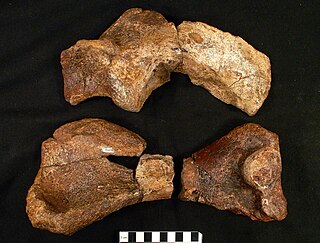
Texasetes is a genus of ankylosaurian dinosaurs from the late Lower Cretaceous of North America. This poorly known genus has been recovered from the Paw Paw Formation near Haslet, Tarrant County, Texas, which has also produced the nodosaurid ankylosaur Pawpawsaurus.
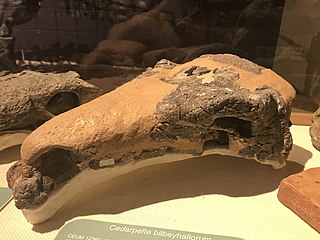
Cedarpelta is an extinct genus of basal ankylosaurid dinosaur from Utah that lived during the Late Cretaceous period in what is now the Mussentuchit Member of the Cedar Mountain Formation. The type and only species, Cedarpelta bilbeyhallorum, is known from multiple specimens including partial skulls and postcranial material. It was named in 2001 by Kenneth Carpenter, James Kirkland, Don Burge, and John Bird. Cedarpelta has an estimated length of 7 metres and weight of 5 tonnes (11,023 lbs). The skull of Cedarpelta lacks extensive cranial ornamentation and is one of the only known ankylosaurs with individual skull bones that are not completely fused together.
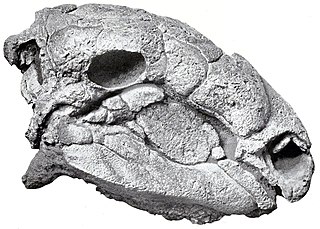
Panoplosaurus is a genus of armoured dinosaur from the Late Cretaceous of Alberta, Canada. Few specimens of the genus are known, all from the middle Campanian of the Dinosaur Park Formation, roughly 76 to 75 million years ago. It was first discovered in 1917, and named in 1919 by Lawrence Lambe, named for its extensive armour, meaning "well-armoured lizard". Panoplosaurus has at times been considered the proper name for material otherwise referred to as Edmontonia, complicating its phylogenetic and ecological interpretations, at one point being considered to have existed across Alberta, New Mexico and Texas, with specimens in institutions from Canada and the United States. The skull and skeleton of Panoplosaurus are similar to its relatives, but have a few significant differences, such as the lumpy form of the skull osteoderms, a completely fused shoulder blade, and regularly shaped plates on its neck and body lacking prominent spines. It was a quadrupedal animal, roughly 5 m (16 ft) long and 1,600 kg (3,500 lb) in weight. The skull has a short snout, with a very domed surface, and bony plates directly covering the cheek. The neck had circular groups of plates arranged around the top surface, both the forelimb and hindlimb were about the same length, and the hand may have only included three fingers. Almost the entire surface of the body was covered in plates, osteoderms and scutes of varying sizes, ranging from large elements along the skull and neck, to smaller, round bones underneath the chin and body, to small ossicles that filled in the spaces between other, larger osteoderms.

Pawpawsaurus, meaning "Pawpaw Lizard", is a nodosaurid ankylosaur from the Cretaceous of Tarrant County, Texas, discovered in May 1992. The only species yet assigned to this taxon, Pawpawsaurus campbelli, is based on a complete skull from the marine Paw Paw Formation.
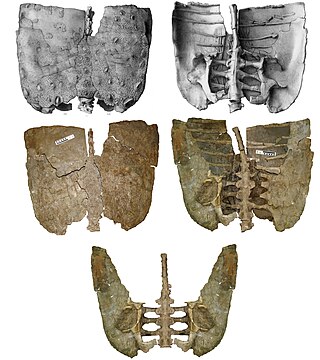
Polacanthinae is a subfamily of ankylosaurs, most often nodosaurids, from the Late Jurassic through Early Cretaceous of Europe and potentially North America and Asia. The group is defined as the largest clade closer to Polacanthus foxii than Nodosaurus textilis or Ankylosaurus magniventris, as long as that group nests within either Nodosauridae or Ankylosauridae. If Polacanthus, and by extent Polacanthinae, falls outside either family-level clade, then the -inae suffix would be inappropriate, and the proper name for the group would be the informally defined Polacanthidae.
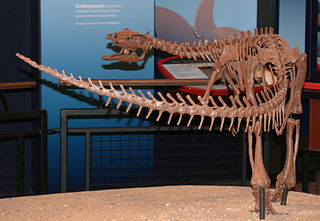
Thescelosauridae is a clade of neornithischians from the Cretaceous of Asia, North America and possibly South America. The group was originally used as a name by Charles M. Sternberg in 1937, but was not formally defined until 2013, where it was used by Brown and colleagues as the group uniting Thescelosaurus and Orodromeus, based on their phylogenetic results. During a phylogenetic revision of neornithischians by Clint Boyd in 2015, the authorship of Thescelosauridae was given to Brown and colleagues, which meant that the similar name Parksosauridae, informally defined in 2002 by Buchholz, would have had priority over Thescelosauridae. The two clades had slightly different definitions, with Parksosauridae referring to all animals closer to Parksosaurus than Hypsilophodon, but they contained the same taxa so Boyd used Parksosauridae under the assumption it had priority. However, in formalizing the clade following the regulations of the PhyloCode, Madzia, Boyd, and colleagues identified in 2021 that Sternberg was the proper authority for Thescelosauridae, giving it priority over Parksosauridae. As well, they gave Thescelosauridae the definition of the largest clade containing Thescelosaurus neglectus but not Iguanodon bernissartensis, as long as Hypsilophodon foxii was not in the group, modifying previous definitions for Thescelosauridae in order to maintain its modern use, so that the clade was not applied if Thescelosaurus fell within Hypsilophodontidae, a family that has not been recently used but may be revived if the systematic position of Hypsilophodon was solidified at some point in the future. Madzia et al. identified the analysis of Madzia et al. in 2018 as the reference analysis for the name Thescelosauridae, an analysis based on a revised version of the 2015 Boyd analysis.

Ahshislepelta is a monospecific genus of ankylosaur dinosaur from New Mexico that lived during the Late Cretaceous in what is now the Hunter Wash Member of the Kirtland Formation. The type and only species, Ahshislepelta minor, is known only from an incomplete postcranial skeleton of a small subadult or adult individual. It was named in 2011 by Michael Burns and Robert M. Sullivan. Based on the size of the humerus, Ahshislepelta is larger than Pinacosaurus mephistocephalus but smaller than Talarurus and Pinacosaurus grangeri.
Dongyangopelta is an monospecific genus of nodosaurid dinosaur that lived in China during the Early to Late Cretaceous period in what is now the Chaochuan Formation. The type and only known species, Dongyangopelta yangyanensis, is known from a partial postcranial skeleton preserving osteoderms and ossified tendons. It was named in 2013 by Rongjun Chen, Wenjie Zheng, Yoichi Azuma, Masateru Shibata, Tianling Lou, Qiang Jin and Xinsheng Jin. Dongyangopelta represents one of the only nodosaurids known from Asia, along with Taohelong and Sauroplites.

This timeline of ankylosaur research is a chronological listing of events in the history of paleontology focused on the ankylosaurs, quadrupedal herbivorous dinosaurs who were protected by a covering bony plates and spikes and sometimes by a clubbed tail. Although formally trained scientists did not begin documenting ankylosaur fossils until the early 19th century, Native Americans had a long history of contact with these remains, which were generally interpreted through a mythological lens. The Delaware people have stories about smoking the bones of ancient monsters in a magic ritual to have wishes granted and ankylosaur fossils are among the local fossils that may have been used like this. The Native Americans of the modern southwestern United States tell stories about an armored monster named Yeitso that may have been influenced by local ankylosaur fossils. Likewise, ankylosaur remains are among the dinosaur bones found along the Red Deer River of Alberta, Canada where the Piegan people believe that the Grandfather of the Buffalo once lived.

Panoplosaurini is a clade of nodosaurid ankylosaurs from the Cretaceous of North America and South America. The group is defined as the largest clade containing Panoplosaurus mirus, but not Nodosaurus textilis or Struthiosaurus austriacus, and was named in 2021 by Madzia and colleagues for the group found in many previous analyses, both morphological and phylogenetic. Panoplosaurini includes not only the Late Cretaceous Panoplosaurus, Denversaurus and Edmontonia, but also the mid Cretaceous Animantarx and Texasetes, as well as Patagopelta. However, in the study describing it, its authors only placed it as a nodosaurine outside Panoplosaurini. The approximately equivalent clade Panoplosaurinae, named in 1929 by Franz Nopcsa, but was not significantly used until Robert Bakker reused the name in 1988, alongside the new clades Edmontoniinae and Edmontoniidae, which were considered to unite Panoplosaurus, Denversaurus and Edmontonia to the exclusion of other ankylosaurs. As none of the clades were commonly used, or formally named following the PhyloCode, Madzia et al. named Panoplosaurini instead, as the group of taxa fell within the clade Nodosaurinae, and having the same -inae suffix on both parent and child taxon could be confusing in future. The 2018 phylogenetic analysis of Rivera-Sylva and colleagues was used as the primary reference for Panoplosaurini by Madzia et al., in addition to the supplemental analyses of Arbour et al. (2016), Brown et al. (2017), and Zheng et al. (2018).

Struthiosaurini is a clade of nodosaurid ankylosaurs from the Cretaceous of Europe and North America. The group is defined as the largest clade containing Struthiosaurus austriacus, but not Nodosaurus textilis or Panoplosaurus mirus, and was named in 2021 by Madzia and colleagues for the relatively stable group found in many previous analyses. Struthiosaurini includes not only the Late Cretaceous European Struthiosaurus, but also the Early Cretaceous European Europelta, the Late Cretaceous European Hungarosaurus, and Stegopelta and Pawpawsaurus from the mid Cretaceous of North America. The approximately equivalent clade Struthiosaurinae, named in 1923 by Franz Nopcsa was previously used to include European nodosaurids, but was never formally named following the PhyloCode, so Madzia et al. named Struthiosaurini instead, as the group of taxa fell within the clade Nodosaurinae, and having the same -inae suffix on both parent and child taxon could be confusing in future. The 2018 phylogenetic analysis of Rivera-Sylva and colleagues was used as the primary reference for Struthiosaurini by Madzia et al., in addition to the supplemental analyses of Arbour et al. (2016), Brown et al. (2017), and Zheng et al. (2018).
Patagopelta is an extinct genus of ankylosaurian dinosaur from the Late Cretaceous Allen Formation of Argentina. The genus contains a single species, P. cristata, known from a partial skeleton. While originally described as a nodosaurine, later discoveries provided support for parankylosaurian affinities for the taxon. Patagopelta is a very small ankylosaur, comparable in size to the dwarf nodosaurid Struthiosaurus, about 2 m (6.6 ft) long.

Vectipelta is an extinct genus of ankylosaurian dinosaur recovered from the Early Cretaceous Wessex Formation of England. The genus contains a single species, V. barretti, known from a partial skeleton including several osteoderms. It was historically known as the "Spearpoint ankylosaur" prior to its description.

















